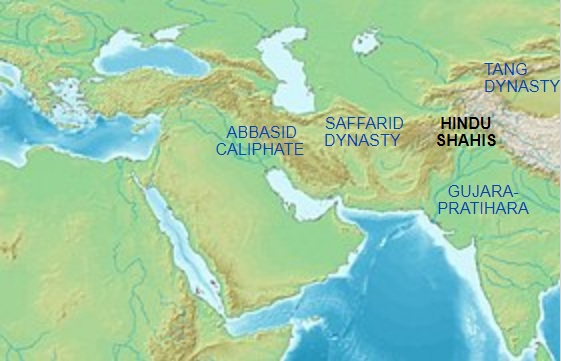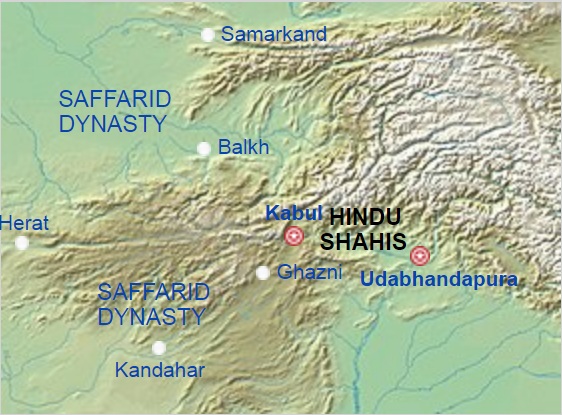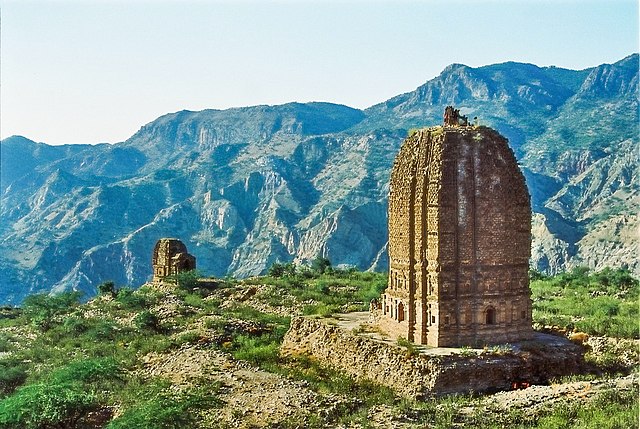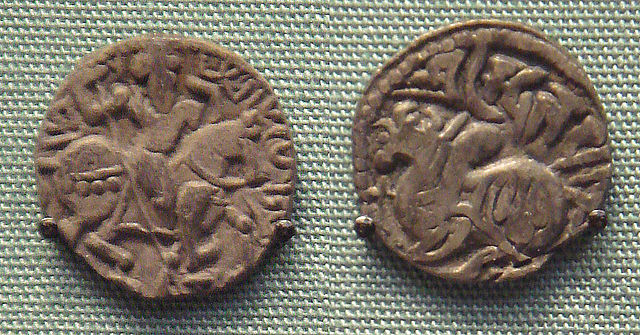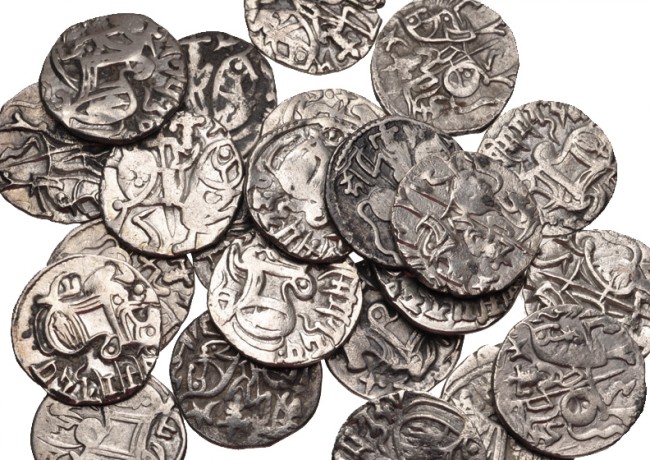
| HINDU SHAHI Hindu Shahi 850 – 1026 CE :
Approximate location of the Hindu Shahis
Kabul, first capital, and Udabhandapura, next capital of the Hindu Shahis Hindu Shahi
850 - 1026 CE
Capital : Kabul (850-870), Udabhandapura (870-1026
Common languages : Bactrian
Religion : Hinduism
Government Shahi : Monarchy
Historical era : Early Middle Ages
• Established : 850
• Disestablished : 1026 CE
Preceded by
Turk shahi
Succeeded by
Saffarid Dynasty
Samanid Dynasty
Ghaznavids
Today part of : Afghanistan, Pakistan and India
The Hindu Shahis or Kabul Shahis (850–1026 CE) was a Hindu dynasty that held sway over the Kabul Valley (Eastern Afghanistan), Gandhar (modern-day Pakistan), and present-day Northwestern India, during the early medieval period in the Indian subcontinent. Details about these rulers have been assembled from chronicles, coins and stone inscriptions by researchers as no consolidated account of their history has become available.
History
:
In 870, King Kallar lost the city of Kabul. He was displaced from there by the local Saffarid dynasty which was ruled by Emir Ya'qub bin Laith as-Saffar. Due to the ongoing conquests of the local Saffarids and Samanids, he moved his capital in 870 to Udabhandapura (Also called Waihund or Hund), located on the banks of the Indus. The loss of Kabul remained short as in 879 CE the Hindu Shahi captured the city back. This victory remained short too due to Samanid expansion in the region which eventually led to the final Shahi rule in Kabul around 900 CE. The Hindu Shahi remained strong in Gandhar and other parts of the Punjab.
The
varna of Shahis of Kabul :
The Amb Hindu Temple complex was built between the 7th and 9th centuries CE during the reign of the Hindu Shahi Empire
Coins of the Hindu Shahis, which later inspired Abbasid coins in the Middle East Defence
of Zabul by Kshatriya Shahis :
In 700-701, Abdur-Rahman ibn Muhammad ibn Al-Ash’ath was dispatched with forty thousand men and was able to collect considerable booty but failed to have any territorial gains – thus incurring the displeasure of Hajjaj. Exasperated by the threats of supersession he determined to carry arms against his master and, in order to strengthen his power, conducted a treaty with the Rutbils that the latter would afford him asylum in the event of the failure of his campaign against the caliph.
After some initial successes, Abdur Rahman was at the end compelled to seek the protection of his Hindu ally. Sustained political intervention of the Rutbil brought the Islamic expansion to a halt and he had made Sistan an ‘ill-omened frontier’ for the Arabs. In folklore Rutbil became the hero of many Arab stories of holy wars on the frontier of Hind. Gradually, the Arabs - the ruling caliphs - ceased to be a powerful political force and Rutbils ruled in comparative peace for another one hundred and fifty years.
Islamic kingdoms in the Shahi neighbourhood :
Hindu Shahi coinage, "bull/horseman" types, circa 850 - 1000 CE
The Samanids and the Saffarids :
The
Hindu Shahi Dynasty of Kabul :
Nine principal issues of Bull and Horseman silver coins and only one issue of corresponding copper coins of Spalapatideva have become available. As many as five Elephant and Lion type of copper coins of Shri Vakkdev are available and curiously the copper issues of Vakk are contemporaneous with the silver issues of Spalapati.
Kabul
Town not attacked :
It was some time during this period that the Hindu Shahis shifted their capital from Kabul to Udabhandapura.
Kamalavarman
attacks Ghazni :
Having successfully dealt with the Saffarids, Ashta (the governor of Kabul) appears to have stayed back and maneuvered a ‘palace coup’. He seized the Shahi throne at Udabhandapura, dislodging his brother Kamalvarman but the state of Kashmir intervened. Rajatarangini records that Prabhakardev the Koshadhyaksh (Superintendent of Treasury) led a victorious expedition against the Shahi power at the town of Udabhandapura and bestowed the kingdom of the rebellious Shahi (Ajna Atikrami Shahi – a Shahi violator of order) upon Tormana, Lalliya's son and gave him the new name Kamaluk. This may have happened in 903 during the reign of child king Gopalavarman (r. 902-904) ruling under the guardianship of his mother Sugandha.[citation needed]
Kamaluk has been identified as Kamalvarman, son of Lalliya (Samantdev). He was succeeded by his son, Bhimdev.[citation needed]
Bhimdev
:
By the middle of the tenth century, Turkish slaves began to acquire power in the Samanid realm, as they were holding principal offices in the court and kingdom. One of these, Alaptagin, a former Hajib or Door Keeper, defeated the superior royal army near Khulm Pass and decided to carve out an independent kingdom for himself. He first took over Bamian ‘the country of the infidel (Hindu) Shir Barak’. He next turned to Ghazni where Lawik, its ruler, submitted after a prolonged siege of four months. Alaptagin thus became the undisputed master of Ghazni but he died soon thereafter and his son Abu Ishaq succeeded him in 963.[citation needed]
Substitution of Hindu potentates of Bamian and Ghazni by an emerging Turkish power posed a serious threat to the Shahi kingdom which acted with ‘remarkable alacrity’ at this stage. The Lawik was sent back to Ghazni with a huge army which ousted the Turks and sent Abu Ishaq flying to Bukhara. The Shahis had secured their western frontier – for the time being. But the gathering storm had not blown away.[citation needed]
Bhimdev
and Kashmir :
End
of Bhimdev :
Though ruling with grandeur, unmolested by any neighbouring kingdom, Bhimdev was getting old and must have been weighing his options in the matter of succession, because he did not have a male heir. The Shahi kingdom was strong and prosperous but not easy to govern - and protect. He could not count either on the Lawiks or his granddaughter Didda of Kashmir for this onerous responsibility. He selected the allied kingdom of Punjab for this honour and probably installed a successor in his own life for the succession seems to have been without ‘contest or convulsion’.
Jaypaldev
:
From the beginning, Jaypal followed an aggressive and pro-active policy towards the Turks. As stated earlier, Abu Ishaq had been evicted from Ghazni and the Lawiks were installed there with Shahi help. In 965, Abu Ishaq regained Ghazni with assistance from the Samanid ruler Abu Mansur and the Lawik fled to ‘Hind’ once again to seek help from the Shahis. Ultimately, Sabuktagin descended the throne of Ghazni in 977. He soon added Bust, Dawar, Qusdar, Tukhristan and Ghur to his dominions. Conflict with ‘Hind’ could not have been postponed for too long.[citation needed]
Jaypaldev
attacks Sabuktagin :
Sabuktagin then became more involved in the affairs of the Samanid state and left the Shahis in peace. He became very powerful in the Samanid Kingdom by virtue of his strong and disciplined army. Sabuktagin died at Balkh in 997 at the age of fifty six. After a struggle for succession with brothers, his son Mahmud ascended the throne of Ghazni in 998. Mahmud first consolidated his position on his western front, even if he had to challenge the authority of his Samani over-lord. Soon he had control over Herat, Balkh, Bust and Khurasan. Recognising his power, the Caliph of Baghdad acknowledged him as a sovereign in his own right and conferred high sounding titles on him. The Ghaznavids had thus acquired a status equal to their former masters – the Samanids. The balance of power had been gradually tilting in favour of Ghazni.[citation needed]
Rulers
:
•
Vakkdev
Source :
https://en.wikipedia.org/ |
